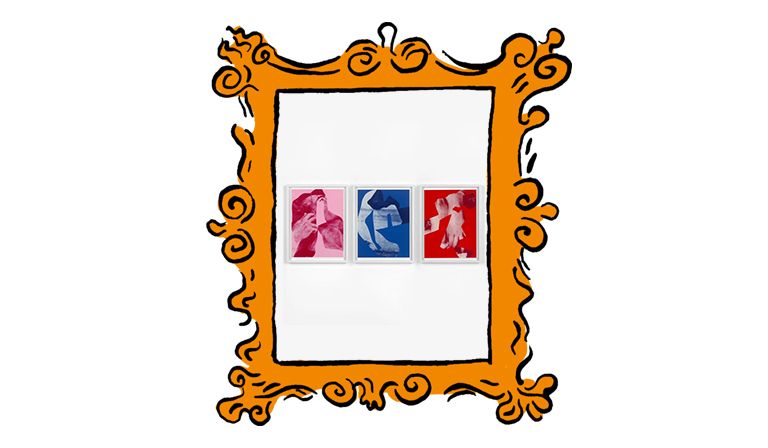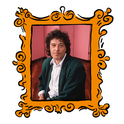On my way through Regent’s Park in central London, I spot the artist Gavin Turk—unmistakeable with his big moustache and pink beret—gently fondling a phallic-looking sculpture by Theaster Gates. At first, I think this is the perfect image to encapsulate Frieze Art Fair: weird but not too weird. Then I make it to the queue.
Frieze, London’s largest art fair by some margin, has taken place in an enormous tent in the park ever since its inception in 2003. On this preview day of the fair, they have divided the queue between “VIPs” and “exhibitors and press”—and it turns out this is enough to bring out the worst kind of narcissism of small differences. Within a space of less than two minutes I watch as person after person attempts to push their way through the exhibitors’ queue without showing their passes, acting dumbfounded when they’re stonewalled by a bouncer. “Charlie, wait,” says one foppish man, looking right past the bouncer as if he doesn’t exist. “Charlie, I’m being stopped.”
And this, I find, is probably how most of us view Frieze: a place where money and entitlement meet art, and not the other way around.
Though anyone with an interest in the art world will have read this classic “Frieze take” a dozen times already. It’s all crass; it’s a millionaire’s supermarket; it’s art at its most commodified. All of that is, of course, completely true—but if you want to understand why Frieze has become one of the art world’s most indispensable events, you’ll have to hold your nose and drink some of the damn champagne.
To Frieze’s credit, they have never pretended to be anything they are not, which is a means for galleries from across the world to sell art by the artists they represent. In that respect, they are already much more honest than many other institutions. If the price tags are missing from the walls, that speaks more to a general feeling among the wealthy that to talk about money in monetary terms is a bit gauche, rather than Frieze trying to sell things by stealth.
The less commented upon aspect of Frieze, however—perhaps because it is not quite as glamorous—is that this is also essentially a B2B expo. For many private galleries, particularly small ones or those not based in a major centre for art, Frieze offers them a serious opportunity to put their artists before audiences they would otherwise never reach.
“I think this is important for galleries regardless of whether you’ve got 12 locations around the world or one in a place like Edinburgh,” says Richard Ingleby, who runs the eponymous Ingleby Gallery in (you guessed it) Edinburgh, “because it’s an environment where people will come and have the opportunity to see a great deal of stuff. That of course works for collectors, but it also works for curators.” Alluding to cuts to the state sector, he points out that curators “don’t necessarily have the resources to be travelling around the country as maybe they might have done 10 or 15 years ago.” The hope isn’t just to sell work, but also to propose shows that bring artists to national prominence.
Some gallerists, including Ingleby, highlight the “curated” aspect of their booths, the idea being that these are mini group exhibitions. The truth, however, is that it’s quite hard to escape the vague jumble sale aesthetic that the environment—with its white cubicles and grey carpet—invites. One notable exception might be the Lisson Gallery booth, which this year has been given over entirely to one artist, Leiko Ikemura, who is also making her first appearance anywhere in the UK.
Ikemura—whose work includes ethereal paintings and translucent sculptures—gives me the impression that she has treated her booth with the same seriousness as she would any gallery show. She worked closely with her husband, an architect, to design the layout of the physical space. One side of the booth is left wide open, while another is cut through by a long oblong podium that comes into the space like a ship sailing under a bridge. On either side of this podium are two of Ikemura’s sculptures. “I wanted this to be an inviting space,” she says, adding that the idea was to use the space to make the work feel like “one story”.
Beyond conceptual ideas about the work itself, Ikemura is tellingly the only person who cites money as a driving force in all this, saying that representation with Lisson allows her to combine the “financial aspect” with curatorial input that is “almost like a museum”. She wouldn’t be at Frieze, or exhibiting in the UK at all, without this combination.
During my short chat with Ikemura, I am interrupted five times by various people who also want to speak to her—and right now. I soon find that this general feeling of being an intruder at somebody else’s family dinner prevails regardless of where I go in the fair.
At the Thomas Dane Gallery booth, I’m amazed to find two small paintings by the Pakistani-American artist Salman Toor. Perhaps one of the most significant painters working in the US right now, Toor has had major solo showings at the Whitney Museum in New York and the Baltimore Museum of Art. With the exception of just one very early work owned (but not displayed) by the Tate, Toor’s non-existent profile in the UK has always been a puzzle; he has yet to have any institutional show here or, indeed, any kind of show at all. Excited, I ask one of the people in the booth if this is the first time Toor’s paintings have ever been shown in the UK. “Good question,” I’m told.
In the end, I found in that quick dismissal a kernel of why Frieze still leaves me feeling just a little icky, despite coming to admire some of the galleries and artists who show here. It’s not because there’s too much money in art. It’s because art, and its significance, becomes almost incidental to the whole equation.
The story of art this century has been one in which private collectors have successfully positioned themselves as the centre of the art world’s wheel; not only its tastemakers but also its chief instigators, shaping what gets made and seen in private galleries and national museums alike. Government apathy towards the arts has not only made this position inevitable but fully entrenched.
There is no going back: clearly, art cannot survive without Frieze. My worry is that one day we’ll discover that we’ve traded one form of indifference for another.
Frieze is the indispensable fair
Art can’t really survive with it. So should we be grateful?
October 10, 2024

Arturo Herrera's "Printer's Proof' at the Thomas Dane Gallery during Frieze










